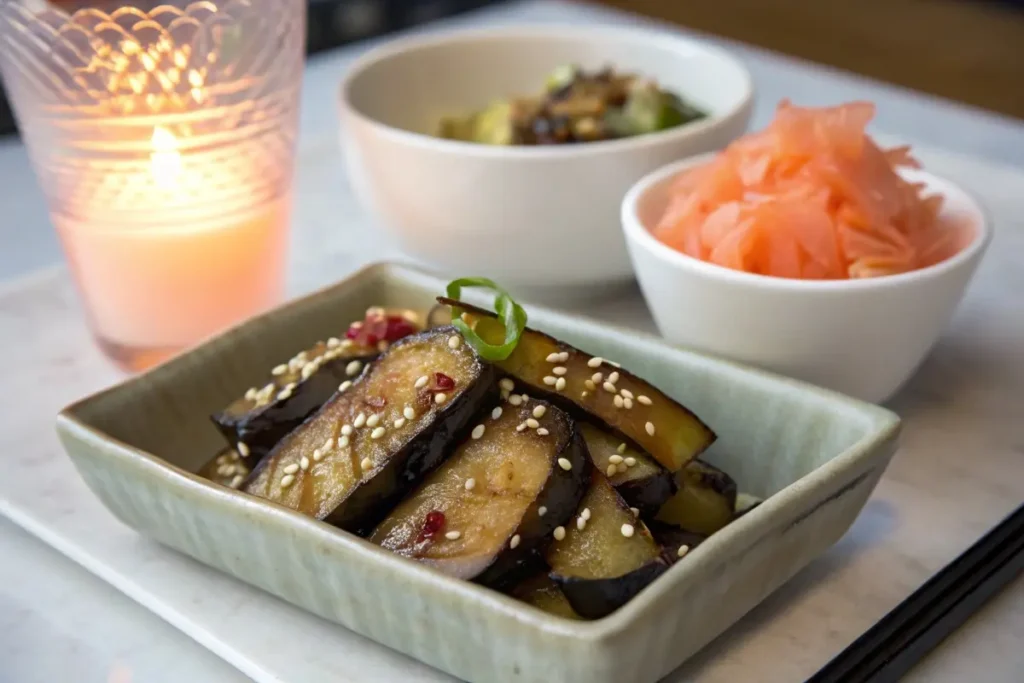Japanese cuisine has a longstanding tradition of pickling vegetables to create bold, palate-pleasing accompaniments—pickled eggplant stands out as a noteworthy classic in this tradition. Known for its tangy, salty, and sometimes sweet flavor profile, pickled eggplant Japanese style remains a hidden gem among the country’s wide range of preserved foods. With each bite, you’ll encounter a crisp, succulent texture that underscores the inherent creaminess of eggplant (nasu in Japanese). This delicious staple, often served alongside rice or as part of a pickles assortment called tsukemono, highlights how a simple brine or marinade can radically transform a humble vegetable into a culinary highlight.
Beyond its taste, this pickled vegetable offers practical benefits—longer shelf life, nutritional value, and an easy way to incorporate vibrant color into meals. Many a Japanese household features homemade or store-bought pickled eggplant, sometimes spiced up with chili or ginger for an added kick. Whether you’re exploring ways to preserve the season’s bounty or looking for a bright side dish to pair with comforting bowls of rice, pickled eggplant Japanese style is a must-try.
If you’re already a fan of fermented or pickled items such as shibazuke or takuan, you’ll discover that pickled eggplant fits seamlessly into your repertoire. For more creative ways to enjoy vegetables, you can also check out our Vegetables Japanese Recipe page, filled with ideas to make veggies sing in your kitchen.
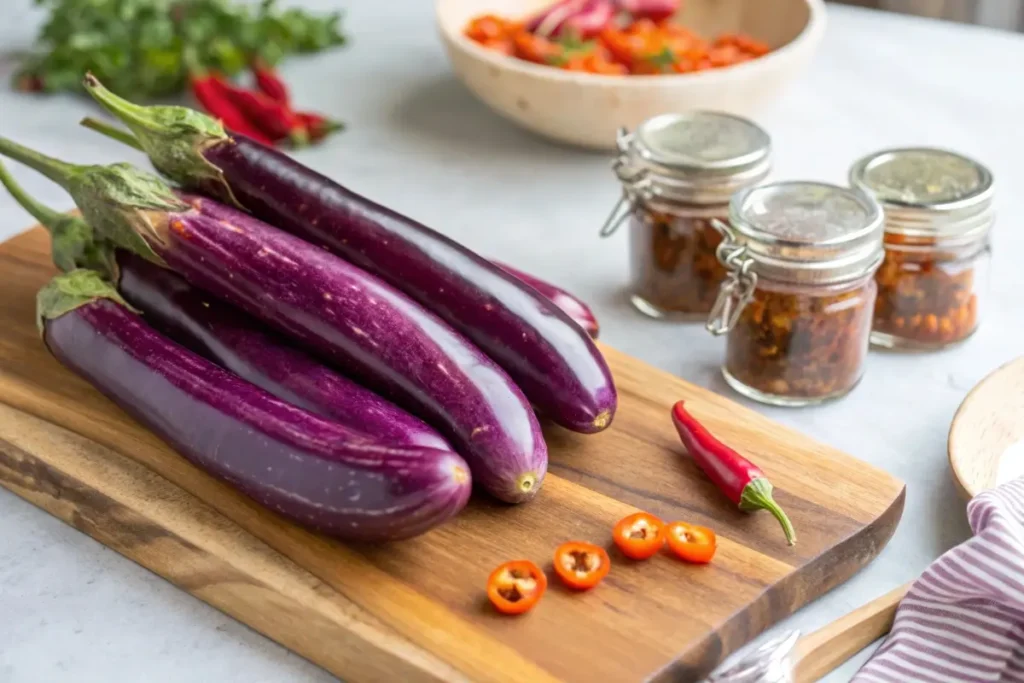
Table of Contents
Understanding Japanese Pickled Eggplant
What Makes Japanese Pickled Eggplant Special?
Eggplant is a beloved vegetable in Japan, prized for its mild taste and spongy interior that easily absorbs flavors. When pickled, it takes on briny, slightly acidic notes that make each bite stand out—particularly when served alongside fluffy rice, miso soup, and other staples. The range of pickling methods can vary from quick refrigerator pickles to more intricate, long-term fermentation. Some recipes keep the eggplant raw and salted, while others lightly blanch or pan-fry before submerging in a marinade.
Texture and Flavor Profile
One of the major appeals of pickled eggplant is the contrast between the vegetable’s original texture and the crisp tang introduced by pickling. Japanese eggplants are typically thinner, longer, and have fewer seeds than Western varieties, which helps them stay tender while offering a gentle crunch after pickling. The brine may include ingredients such as vinegar, salt, soy sauce, mirin, or sake, and often a hint of sweetness to balance acidity. Spices like ginger, chili, or garlic can be added to impart distinct, savory undertones.
Pickling Approaches
- Salt-Only Quick Pickle (Asazuke style): Eggplants are salted, lightly pressed, and left to drain. This method emphasizes the vegetable’s inherent sweetness while drawing out moisture.
- Vinegar-Based Marinade: Commonly used for a sharper taste and extended shelf life. Vinegar levels vary, from mild rice vinegar to stronger distilled vinegar.
- Soy Sauce Brine: Adds an umami dimension. This style is often reminiscent of shibazuke, though typically that includes cucumbers, red shiso, or other vegetables.
- Oil-Preserved Eggplant: Some versions use sesame oil or vegetable oil to yield a rich flavor, reminiscent of Mediterranean-inspired pickled eggplant.
Health Benefits
Wondering what are the benefits of pickled eggplant? Eggplants themselves are good sources of dietary fiber, vitamins, and minerals such as manganese and potassium. Pickling can introduce beneficial bacteria if fermentation is involved, potentially aiding gut health. Additionally, many pickled vegetables—eggplant included—are lower in calories, making them a flavorful yet figure-friendly side dish. That said, pickled foods can be high in sodium, so enjoying them in moderation is best.
Serving Suggestions
Pickled eggplant is typically presented as a side dish or garnish, providing acidity that balances heavier items like grilled fish or Japanese Chicken Fried Rice Recipe. Enjoy it plain, or add a sprinkling of sesame seeds, red pepper flakes, or shredded ginger. You can also slice pickled eggplant to top salads or tuck it into sandwiches for a tangy twist. If you prefer your eggplant pickles sweet, a small spoonful of honey or sugar can round out the flavors.
Culinary Versatility
Given the wide variety of pickling solutions—salt-based, vinegar-based, soy sauce-infused—there’s an option for every palate. For instance, a bold chili-infused marinade suits those who enjoy a spicy punch, whereas a gentler vinegar-salt combination might be ideal for mild tastes. Once you master a basic technique, it’s easy to experiment with add-ins like shiso leaves, kombu, or chili peppers to create your own signature pickled eggplant.
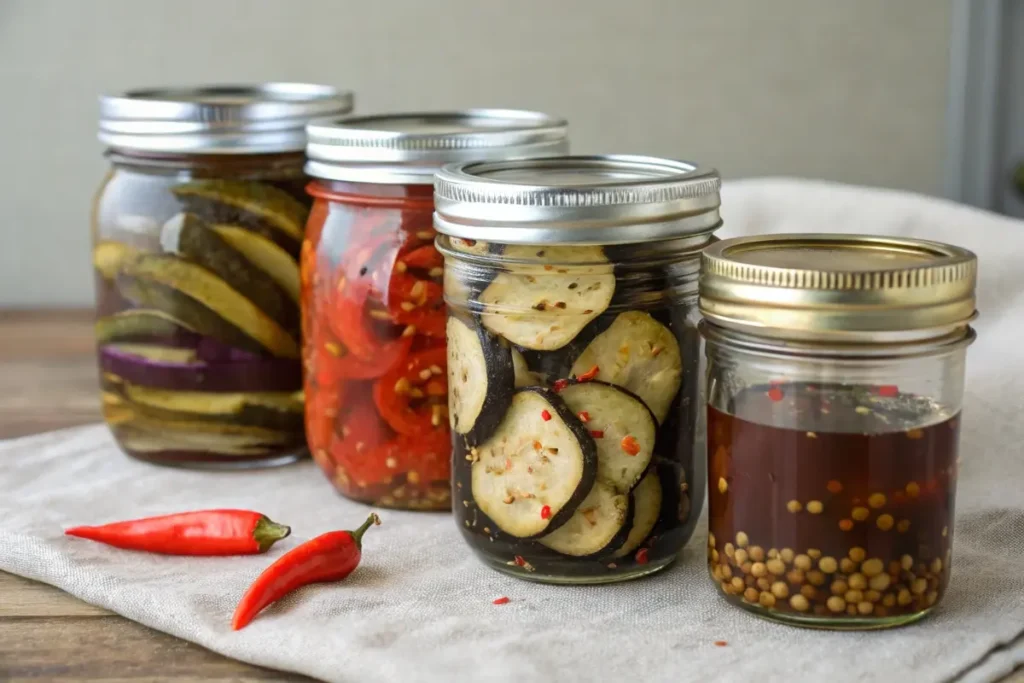
Choosing and Preparing Your Eggplants
Selecting the Right Variety
In Japan, slender “Japanese eggplants” reign supreme for pickling. Their delicate skin and lower seed content ensure a smoother bite and help them absorb flavors quickly. They also have a subtle sweetness that pairs beautifully with tangy pickling solutions. If you can’t find Japanese eggplants in your local market, you can still use other thin-skinned eggplant varieties. However, be mindful that they may need extra salting or peeling to achieve similar results.
Assessing Freshness
- Skin: Look for eggplants with shiny, taut exteriors. Dull or wrinkled skin indicates older produce.
- Weight: They should feel relatively heavy for their size.
- Stems: Fresh, green stems usually signify that the eggplant hasn’t been sitting around for too long.
Pre-Pickling Steps
- Wash Thoroughly: Remove any dirt or pesticide residues.
- Optional Soak: Some cooks prefer soaking eggplants in saltwater to reduce bitterness. For Japanese varieties, this step is less critical since they’re naturally milder.
- Slicing Techniques: Decide if you’ll slice them into rounds, half-moons, or sticks. Thinner cuts pickle faster, while chunkier pieces maintain more of the eggplant’s natural texture.
Blanching or Salting
To ensure a pleasant texture, some recipes call for blanching slices in lightly salted water before pickling. This step helps maintain color—preventing the eggplant from turning brown—and softens its fibrous structure. Alternatively, you can salt slices and let them drain in a colander for 15–30 minutes, drawing out moisture and bitterness. Either method sets the stage for even brine penetration.
Seasoning Options
- Classic Vinegar Mix: Combine rice vinegar, water, sugar, and salt (ratio typically 1:1:0.5:0.5 for a moderate sweet-sour profile).
- Soy-Vinegar Fusion: Add a splash of soy sauce for extra umami depth.
- Chili Infusion: Slide in a few fresh chili slices or dried chili flakes for a subtle or intense kick, depending on your tolerance.
- Herbal Twists: Consider ginger slices, shiso leaves, or garlic cloves to impart a unique aroma.
Tools You Need
- Sharp Knife: For clean, uniform slices.
- Cutting Board: Wooden or plastic, large enough to handle multiple eggplants.
- Glass or Food-Grade Plastic Containers: Non-reactive containers are best for acidic brine.
- Measuring Cup and Spoon: Precision can make a difference in balanced flavor.
Handling Safety
Eggplants can brown quickly when exposed to air, so aim to slice them just before pickling to reduce oxidation. Store them in an airtight container in the fridge if you’re not brining immediately. If making a large batch, proceed with smaller quantities at a time to keep freshness intact. Also, ensure your jars or containers are thoroughly washed—sterilizing them in boiling water is an option if you plan a longer pickling process.
Pairing with Other Vegetables
Pickled eggplant pairs wonderfully with cucumbers, daikon radish, or other produce in the same jar. So, if you’d like to experiment with Japanese purple pickled vegetables, consider adding a handful of diced radishes or cucumbers. Just remember to adjust your brine ratio accordingly and consider each vegetable’s water content.
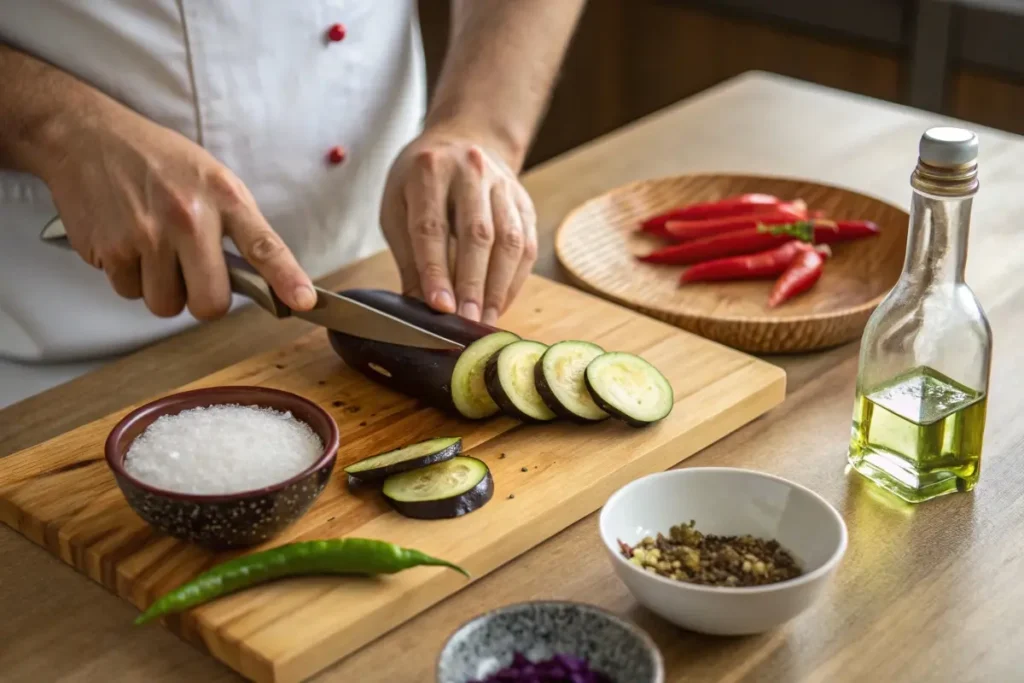
Pickling Methods and Recipes
1. Quick Refrigerator Pickled Eggplant
Ideal for: Beginners or those short on time.
- Ingredients:
- 2–3 Japanese eggplants (sliced)
- 1 cup rice vinegar
- 1 cup water
- 1 tbsp salt
- 1 tbsp sugar
- Optional: chili flakes or ginger slices
Steps:
- Salt the slices, let them rest for 15 minutes.
- Rinse and pat dry.
- Heat vinegar, water, salt, and sugar just until sugar dissolves.
- Pack eggplants into a jar, add optional chili or ginger.
- Pour brine, seal tightly, and refrigerate.
- Let sit at least 4–6 hours before serving.
2. Soy-Infused Pickled Eggplant
Ideal for: A deeper, umami flavor reminiscent of miso or soy sauce marinades.
- Ingredients:
- 2 Japanese eggplants
- 1/2 cup rice vinegar
- 1/2 cup water
- 2 tbsp soy sauce
- 1 tbsp mirin (or sugar)
- Pinch of chili flakes
Steps:
- Briefly blanch eggplant slices for 1–2 minutes.
- In a small saucepan, warm vinegar, water, soy sauce, and mirin, stirring.
- Arrange eggplant in a sterilized jar, adding chili flakes.
- Pour the warm marinade over.
- Cool to room temperature, then refrigerate for at least 8 hours.
This approach yields a pickled eggplant loaded with savory notes—perfect as a side dish with grilled fish or in a bento box.
3. Shibazuke-Inspired Variation
Ideal for: Fans of tangy, colorful pickles.
- Ingredients:
- 2 Japanese eggplants
- 2 tbsp salt
- 1 cup water
- 1/4 cup vinegar
- Red shiso leaves or red cabbage leaves (for color)
- 1 tsp grated ginger
Steps:
- Slice eggplants; rub them with salt, let rest 30 minutes.
- Rinse, pat dry.
- In a bowl, combine water, vinegar, ginger, and any optional add-ins like shiso or red cabbage leaves.
- Submerge eggplant slices, press down with a small plate to keep them fully immersed.
- Refrigerate overnight.
You’ll be rewarded with brilliant purple or pinkish eggplant slices that resemble shibazuke, but with an eggplant emphasis. The red shiso or cabbage ensures that signature hue.
Extended Storage
Wondering how do you preserve Japanese eggplant for longer? For a shelf-stable approach, consider boiling your vinegar-based brine, packing eggplants into sterilized jars, and using a water-bath canning method (common in Western pickling). Keep in mind, though, that these methods might alter the eggplant’s texture. If you prefer a crisp, fresh bite, short-term refrigeration pickles are best.
Troubleshooting
- Mushy Texture: Overcooking or leaving them in brine too long can cause softening. Reduce blanching time.
- Overly Salty: Rinse eggplant slices thoroughly after salting, or cut back on salt in your brine.
- Uneven Color: Ensure slices are uniformly cut and fully submerged. Shaking or gently stirring the container can help.
Additional Serving Ideas
- Dice pickled eggplant for a tangy relish.
- Pair with cheese, crackers, or sake for a modern twist on charcuterie boards.
- Stir into stir-fries at the last minute for a burst of acidity.
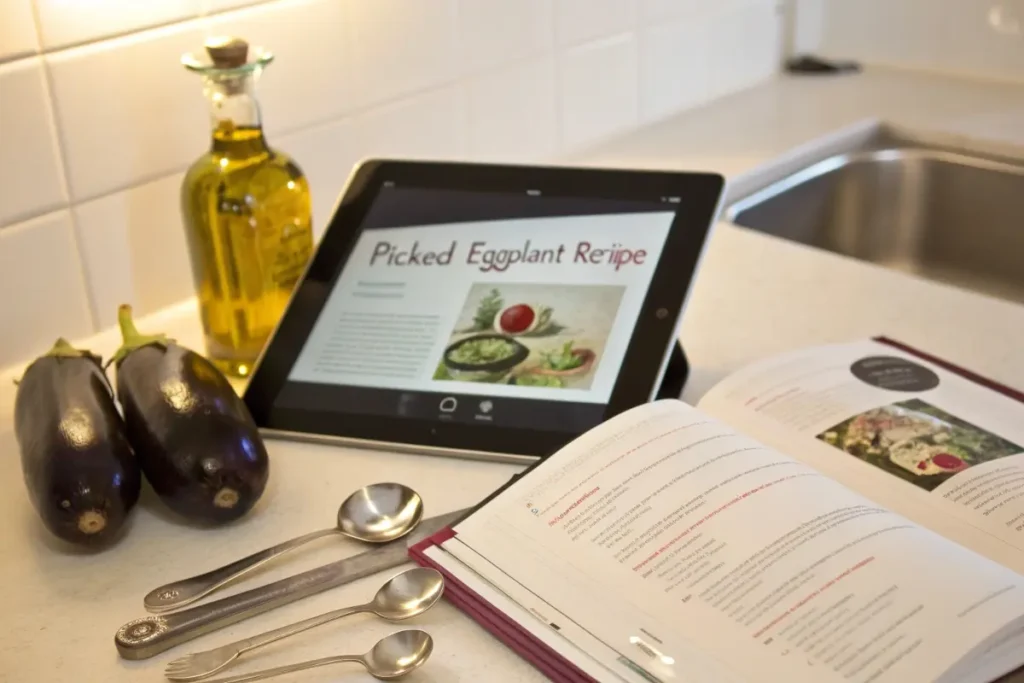
History and Context
Ancient Roots of Pickled Foods
Pickling in Japan dates back centuries, developed partly as a means to preserve summer produce for colder seasons. Vegetables like daikon radishes, cucumbers, and eggplants took center stage in the realm of tsukemono. Over time, regional differences evolved in the way foods were pickled, influenced by local climate, available spices, and cultural preference for certain flavors—like sweet-savory in the Kansai region or bold-sour in Kanto.
The Emergence of Pickled Eggplant
While eggplant arrived in Japan from China, it soon adapted to local conditions. Because the climate in many areas is hot and humid, preserving eggplant became practical. Historically, it was done with a mixture of salt, sake lees, or miso, yielding deep, layered flavors. In Edo-period Tokyo, pickled vegetables gained popularity as more commoners sought quick side dishes to accompany rice and fish. Over centuries, pickled eggplant recipe variations multiplied—some focusing on color retention, others on subtle smoky undertones from charcoal or nukadoko (rice bran bed).
Connection to Seasonal Eating
Japanese culture values “shun,” or seasonal produce at peak freshness. Eggplant’s peak in summer led to innovative pickling solutions so people could enjoy it year-round. Those bright purple slices, particularly in the summer months, brought not just flavor but also visual charm to meals. Even today, many families and restaurants continue these traditions, often adding new spices or techniques to keep the practice alive.
Global Influence
Interest in Japanese cuisine expanded globally in the late 20th century, turning ordinary items like pickled eggplant Japanese style into sought-after delicacies. Food enthusiasts found that pickled eggplant bridged a flavor gap—providing tanginess that balanced heavier dishes. As more people discovered the joys of fermented and pickled items, shibazuke, takuan, and pickled eggplant gained traction on international tables. Nowadays, chefs worldwide incorporate these tangy treats in fusion menus, blending East and West approaches to pickling. For an even broader perspective on staple produce in Japan, check out our Japanese Radish Recipe page, which delves into other root-vegetable pickles and dishes.
Modern Adaptations
Contemporary Japanese households might rely on store-bought pickles—often found in small vacuum-sealed packages. Yet many still prefer homemade versions for tailor-made flavors. With the rise of home gardening, folks often experiment with their garden’s eggplant surplus, turning them into delicious pickles to share with friends or store away for winter. Whether in rural villages or bustling cities, this tradition carries on, bridging the gap between the past’s necessity and the present’s culinary curiosity.
Practical Examples/Use Cases
1. Bento Box Inclusions
Looking to diversify your lunch? A small container of pickled eggplant adds a refreshing tang that cuts through rich elements such as fried chicken or creamy potato salad. The firm, slightly crunchy texture ensures it won’t get soggy, making it an excellent addition to a bento box. If you have leftover eggplants, pair them with Japanese Vegan Recipes for a plant-based feast.
2. Party Appetizers
Entertaining guests? Skewer small slices of pickled eggplant with cherry tomatoes and cubes of tofu or mozzarella for a creative East-meets-West snack. The tang of vinegar pairs well with creamy cheese, while the color contrast looks appealing on a platter. A drizzle of sesame oil or a sprinkle of toasted sesame seeds can enhance the overall bite.
3. Taco Toppers
While not traditionally Japanese, you can add a unique flair to tacos by topping grilled fish or chicken with pickled eggplant. The acidity brightens the dish, complementing typical taco flavors like lime and cilantro. It’s a perfect way to fuse global cuisine with Japanese influences.
4. Sandwich Filling
For vegetarian or vegan sandwiches, pickled eggplant can substitute pickled cucumbers for a less watery, more substantial filling. Combine it with hummus, roasted peppers, or spinach on crusty bread for a satisfying lunch. This approach extends the concept of pickling to mainstream meals without overshadowing the main flavors.
5. Rice Bowl Enhancement
A simple bowl of steamed rice topped with pickled eggplant, a fried egg, and a drizzle of soy sauce can be incredibly comforting. The tangy pickles bring a zesty dimension, ensuring the dish remains interesting bite after bite. If you want a balanced meal, add slices of Japanese Chicken Fried Rice Recipe alongside or a side of miso soup.
6. Gift Jars
For a more thoughtful, homemade gift, prepare small jars of pickled eggplant and decorate them with fabric lids or colorful labels. They’re ideal for food-loving friends who appreciate unique taste experiences. Let them know the recommended pairings (e.g., rice, noodles, grilled meats), and you’ve essentially handed over a mini cooking adventure.
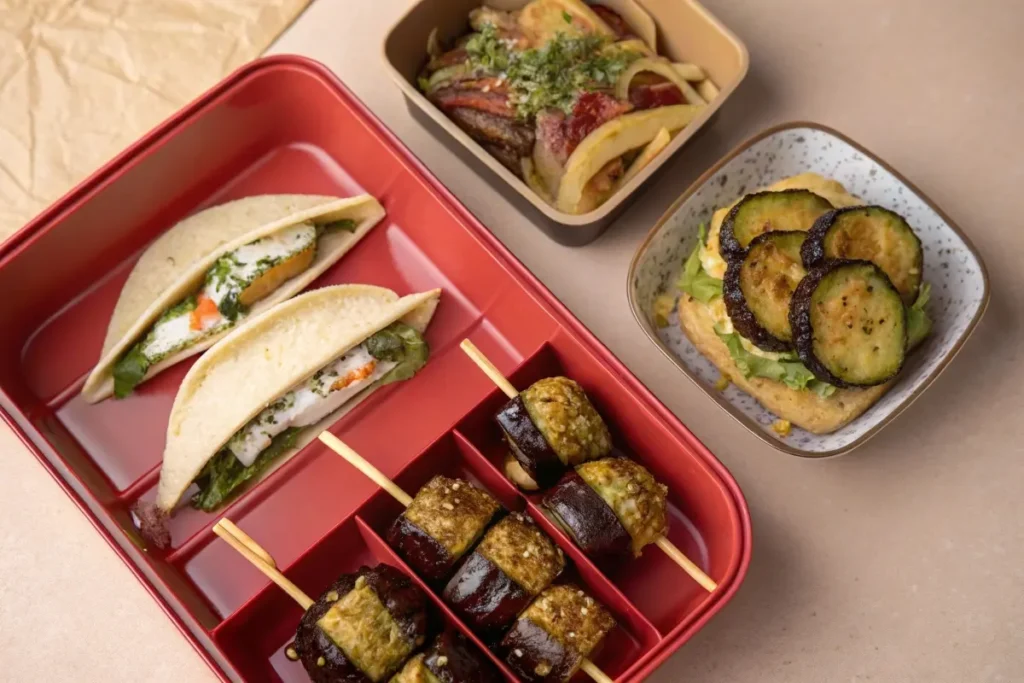
FAQs
1. What are the benefits of pickled eggplant?
Pickled eggplant offers a lower-calorie, high-fiber way to add flavor to meals. The pickling process can help preserve nutrients, and if fermented, it may introduce beneficial bacteria for gut health. Eggplants also contain antioxidants like nasunin, known to support overall wellness.
2. What is the Japanese purple pickled vegetable?
Many Japanese pickles feature bright purple hues, often from red shiso or natural pigments within the vegetables. Shibazuke is a well-known purple pickle made with cucumbers, eggplant, and red shiso. Pickled eggplant can also turn a deep purple color, especially if combined with shiso leaves during pickling.
3. What is the difference between Japanese eggplant and regular eggplant?
Japanese eggplant is typically thinner, more elongated, and has a sweeter, less bitter taste than large globe eggplants. It also contains fewer seeds, resulting in a smoother texture. For pickling, the slender shape helps achieve even brining, and the milder flavor ensures that vinegar, salt, or soy sauce truly shine.
4. How do you preserve Japanese eggplant?
Preservation methods can range from short-term fridge pickles (which last about a week) to more robust canning processes for extended storage. One popular approach is submerging sliced eggplants in a vinegar-soy mixture. For shelf stability, consider using a boiling-water canning method, ensuring jars are properly sterilized. Another method is oil preservation, though it requires careful handling to avoid spoilage.
5. Does pickling eggplant change its nutritional value significantly?
Pickling can slightly alter nutrient levels, especially heat-sensitive vitamins if you heat your brine. However, the fiber and certain minerals remain intact. The addition of salt and possible sugar means you should enjoy them in moderation, but they remain a healthy choice compared to many highly processed snacks.
6. Can I use pickled eggplant to replace other pickles in recipes?
Yes, absolutely. Anywhere you might use pickles—sandwiches, salads, or side dishes—pickled eggplant can deliver tang and texture. It works especially well in Asian-inspired or fusion recipes.
7. Why does my pickled eggplant taste bitter?
Bitter notes can stem from older or off-season eggplants. Salting or blanching them beforehand usually mitigates the bitterness. Also, ensure you remove any large seeds that might intensify the flavor.
Conclusion
Pickling is an art that transforms humble produce into flavor-packed staples, and pickled eggplant Japanese style is no exception. By combining the natural sweetness of slender eggplants with tangy, salty, or umami-rich brines, you can craft a dish that’s both nuanced and practical. From quick refrigerator pickles to more elaborate soy sauce-infused versions, each method brings out a unique characteristic of the vegetable. Whether you’re drawn in by the crisp texture, the vibrant purple hue, or the curiosity to explore new flavors, pickled eggplant promises a tantalizing addition to your table.
All it takes is a little prep work—choosing fresh, firm eggplants, slicing them to your preference, and experimenting with brine ratios that suit your palate. In the end, you’ll have a versatile side that pairs seamlessly with rice, noodles, or grilled proteins. And for the adventurous, this tangy delight makes for an inventive twist on salads, sandwiches, and more. Ready to experience the wonders of pickled eggplant Japanese style in your own kitchen? Begin with a simple recipe, explore add-ons like ginger or chili, and watch how quickly this pickled creation becomes a household favorite. For other ways to harness Japanese culinary creativity, check out our comprehensive Japanese Recipes collection.
